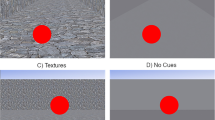Abstract
The probability of shaping the development of zoetrope in the wagon-wheel effect (WWE) phenomenon, shaping the performance of Barberpole illusion (BPI) on a triangular prism, pentagonal prism, heptagonal prism, and cylinder in the WWE was studied by experimentation. The shaping performance of a cylinder in the WWE has such phenomena as “clockwise and anticlockwise rotation” of the cylinder, “downward movement of line and upward movement of line” of the lines on the cylinder, “line afterimage phenomenon” of the lines on the cylinder, and failure in discrimination (no rotation or line movement phenomenon). 18 students participated in the study. The experimental results show that (1) the number of prism edges (excluding cylinder) and the number of failed discriminations increased by alternating rotations. The cylinder had the most prolonged flicker effect regarding clockwise or anticlockwise rotation performance. It was the last one having the clockwise-anticlockwise alternation compared with the other prisms. (2) All prisms have about the same number of downward and upward lines alternations. Regarding the number of alternations, the cylinder was the first to change from downward to the upward movement of lines, and the triangular prism was the last one. (3) The cylinder had the most prolonged downward movement of lines, while all the prisms were coincident in presenting the upward movement of lines. The number of prism edges positively influenced the number of failures in discriminations. (4) Different viewing distances had the same performance in the WWE of a cylinder.
Access this chapter
Tax calculation will be finalised at checkout
Purchases are for personal use only
Similar content being viewed by others
References
Andrews, T., Purves, D.: The wagon-wheel illusion in continuous light. Trends Cogn. Sci. 9(6), 261–263 (2005)
Purves, D., Paydarfar, J.A., Andrews, T.J.: The wagon wheel illusion in movies and reality. Proc. Natl. Acad. Sci. 93(8), 3693–3697 (1996)
Simpson, W.A., Shahani, U., Manahilov, V.: Illusory percepts of moving patterns due to discrete temporal sampling. Neurosci. Lett. 375(1), 23–27 (2005)
VanRullen, R., Reddy, L., Koch, C.: Attention-driven discrete sampling of motion perception. Proc. Natl. Acad. Sci. 102(14), 5291–5296 (2005)
Kline, K.A., Holcombe, A.O., Eagleman, D.M.: Illusory motion reversal is caused by rivalry, not by perceptual snapshots of the visual field. Vision. Res. 44(23), 2653–2658 (2004)
Kline, K.A., Holcombe, A.O., Eagleman, D.M.: Illusory motion reversal does not imply discrete processing: reply to Rojas et al. Vis. Res. 6(46), 1158–1159 (2006)
Kline, K.A., Eagleman, D.M.: Evidence against the temporal subsampling account of illusory motion reversal. J. Vis. 8(4), 13 (2008)
Chen, G.D., Chang, C.C., Lin, P.C.: A study on the induced motion of the rotative speed and the width of line. Issue Basic Des. Art 16, 19–22 (2007)
Oyama, T., Imai, S., Wake, T.: New Sensory Perception Psychology Handbook. Seishin Shobo Ltd, Tokyo (2000)
Tseng, C.H., Lai, Y.Z., Chang, Y.D.: How to make a stereogram. Sci. Educ. Monthly 246, 38–44 (2002)
Finlay, D.J., Dodwell, P.C.: Speed of apparent motion and the wagon-wheel effect. Percept. Psychophys. 41(1), 29–34 (1987)
VanRullen, R., Koch, C.: Is perception discrete or continuous? Trends Cogn. Sci. 7(5), 207–213 (2003)
Author information
Authors and Affiliations
Corresponding author
Editor information
Editors and Affiliations
Rights and permissions
Copyright information
© 2022 The Author(s), under exclusive license to Springer Nature Switzerland AG
About this paper
Cite this paper
Chen, GD., Fan, H. (2022). Barberpole Illusion Shaping Performance of Wagon-Wheel Phenomenon in Stroboscopic: An Investigation on Rotation Direction and Line Movement. In: Stephanidis, C., Antona, M., Ntoa, S. (eds) HCI International 2022 Posters. HCII 2022. Communications in Computer and Information Science, vol 1581. Springer, Cham. https://doi.org/10.1007/978-3-031-06388-6_16
Download citation
DOI: https://doi.org/10.1007/978-3-031-06388-6_16
Published:
Publisher Name: Springer, Cham
Print ISBN: 978-3-031-06387-9
Online ISBN: 978-3-031-06388-6
eBook Packages: Computer ScienceComputer Science (R0)




